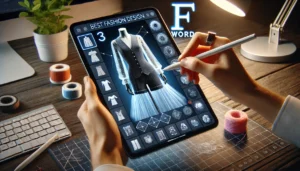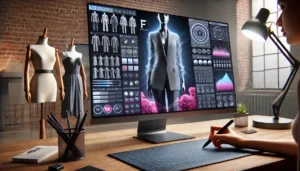AI fashion. These two words probably weren’t printed together in Vogue very often a couple of years ago, but AI is making a splash in all kinds of industries – even creative ones. While some worry AI will steal jobs from designers, that doesn’t seem to be the case. In truth, this tech offers some intriguing tools to make the industry more efficient and maybe even more sustainable. This begs the question: what exactly is AI fashion?
What is AI Fashion?
AI fashion uses artificial intelligence to streamline and even revolutionize different aspects of the fashion world. AI algorithms can predict trends, create hyper-realistic virtual models, and generate completely new designs with a few clicks.
AI for Fashion Design
Imagine software that can take a fashion designer’s rudimentary concepts for a new clothing line and generate multiple variations. These variations can explore different fabrics, colors, and patterns based on input about the desired aesthetic. Believe it or not, this technology already exists.
Generative AI platforms are starting to pop up to help fashion designers brainstorm and explore far more design possibilities. These platforms reduce the need to spend hours sketching or building costly physical prototypes. Some programs, like those used to develop designs for an AI fashion show put on by the Laboratory for Artificial Intelligence in Design (AiDLab), even incorporate data analysis.
For instance, an AI tool could process data from social media, spotting trending colors, styles, or keywords people use to describe what they’re looking for. This kind of analysis helps designers get a real-time feel for consumer desires, potentially helping them craft clothing lines with broader appeal. And because it involves analyzing existing clothes and trends rather than constantly making new materials, there’s an argument to be made that AI fashion can even promote sustainability.
The Rise of Virtual Models and AI-Generated Marketing
Have you ever scrolled through an online shop and wished you could see how those jeans look on an actual person – maybe even someone with your body type? Virtual models and AI-generated imagery are starting to change the game in online fashion marketing. Some AI platforms can take a flat photo of a garment and digitally render it on different models.
Businesses like Bodify specialize in crafting AI avatars of actual customers based on their measurements. This means brands could eventually allow shoppers to create their own avatars, virtually try on outfits, and see how clothes hang and drape based on their exact body shape. The impact of virtual try-ons goes beyond just boosting sales.
According to the National Retail Federation, returns from online sales cost retailers an incredible $212 billion in 2022. If virtual try-on experiences give shoppers a better feel for fit and appearance, it could mean a significant drop in returns for the industry.
But what about the marketing side? Many of us have encountered targeted ads online based on our browsing history, but AI takes this to another level. McKinsey believes that GenAI could bring as much as an additional $275 billion to the apparel, fashion, and luxury sector by 2026, and marketing is a huge part of this. Using real-time data analysis of browsing behavior and purchase history, brands could use AI to create personalized ads and even curated product recommendations that align perfectly with a shopper’s style preferences.
AI’s Impact on the Fashion Industry
Change can be scary. But does embracing AI in the fashion world really have to mean replacing humans entirely? The answer is no. Instead of fearing robot overlords coming for their jobs, perhaps the best way to view the relationship is one of collaboration.
The reality is, there’s a growing number of ways that brands can utilize this technology. Fashion houses such as Valentino and Moncler are already diving headfirst into the world of AI-generated images for striking new marketing campaigns, while designers like Ganni and Collina Strada have captivated audiences with fashion shows that showcase clothing lines inspired by – or even created with the help of – AI tools. There’s no denying the impact AI has. And with investments in this sector rising every day, AI doesn’t seem like a passing fad.
Last year, companies that focus on AI technology received more than $29 billion in funding, an increase of over 260 percent from 2022 alone, according to a Pitchbook report.
Let’s break this down further:
Reimagining Customer Experience With Virtual Try-Ons
While many associate AI with the abstract world of algorithms, this technology also offers a solution to one of fashion’s biggest hurdles. This hurdle is bridging the gap between online shopping and in-store experiences. Several fashion retailers are incorporating AI technology by using innovative new virtual try-on tools like Fringuant, Bods, 3DLook, and Sizekick into their online stores.
From high-end fashion houses like Balmain and Marc Cain, to brands like Vanessa Bruno, Sandro, Maje, Ba&sh, and even popular retailers like Bershka, offering customers the option to visualize a garment’s fit using virtual try-ons creates an online experience that rivals the traditional in-store changing room. In some cases, this online experience even surpasses the in-store one. Think of it this way: a shopper no longer needs to worry whether that amazing dress they saw while browsing their favorite online boutique will actually flatter their figure because, using AI, they now have the option to create a digital representation of themselves using virtual platforms. These virtual platforms, driven by data from each unique shopper, make it possible to try on garments from the comfort of their homes, helping to take much of the guesswork out of choosing the correct size.
From Trend Forecasting to Optimizing Supply Chains
This kind of AI fashion utilizes deep learning and large datasets of consumer preferences. With data gathered on purchasing patterns, social media activity, and even factors like weather, an AI-driven system can generate eerily accurate forecasts of future trends.
Beyond assisting designers, consider the behind-the-scenes implications. Imagine an AI system that analyzes a brand’s inventory, maps out their manufacturing process, then optimizes it for peak efficiency based on current demand and upcoming trends. These AI systems could also make suggestions that cut down on unnecessary manufacturing and minimize waste. This could lead to faster production timelines and more sustainable practices for brands willing to adapt.
Conclusion
There’s no doubt AI is beginning to revolutionize fashion. But is it good, bad, or a little of both? Only time will tell if this technology truly lives up to its potential to make the industry more efficient and sustainable. But, AI fashion is more than just flashy AI-generated designs on a runway. It represents a fundamental shift in how clothes are designed, marketed, and experienced by everyday consumers.
Frequently Asked Questions
1. How does AI benefit fashion designers?
AI provides tools that allow designers to create multiple design variations, analyze trends, and access data on consumer preferences. This not only streamlines the design process but can also reduce time spent on physical prototypes.
2. Can AI help make fashion more sustainable?
Yes. AI can contribute to sustainability by optimizing supply chains, minimizing waste through data-driven forecasting, and reducing the need for physical samples and materials.
3. What is a virtual try-on, and how does it work?
A virtual try-on uses AI to digitally render clothes onto virtual avatars, helping consumers see how garments might look on them without trying them on in-store. This technology can be based on user measurements or even allow users to create personalized avatars.
4. Are virtual try-ons more effective than in-store experiences?
Virtual try-ons can offer a similar or even better experience for shoppers by allowing them to see clothes on a digital representation of their own body. This technology can help reduce guesswork about sizing and fit, making it more convenient for online shoppers.
Similar Reads:


